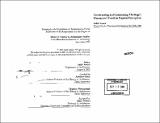| dc.contributor.advisor | Arindam Dutta and Heghnar Watenpaugh. | en_US |
| dc.contributor.author | Ansari, Sadaf, 1978- | en_US |
| dc.contributor.other | Massachusetts Institute of Technology. Dept. of Architecture. | en_US |
| dc.date.accessioned | 2011-06-06T17:42:49Z | |
| dc.date.available | 2011-06-06T17:42:49Z | |
| dc.date.copyright | 2003 | en_US |
| dc.date.issued | 2003 | en_US |
| dc.identifier.uri | http://hdl.handle.net/1721.1/63223 | |
| dc.description | Thesis (S.M.)--Massachusetts Institute of Technology, Dept. of Architecture, 2003. | en_US |
| dc.description | Includes bibliographical references (p. 141-146). | en_US |
| dc.description.abstract | A host of political and spiritual associations were constructed around Humayun's Tomb that established it as the most important political and spiritual site in the city during the sixteenth century. After an initial phase of importance, the tomb began to slip into physical decrepitude and neglect. Though the tomb underwent several changes in the subsequent three centuries, it never regained its original status as a 'Mughal dynastic icon'. One of the primary aims of the intervention efforts by various agencies like the ASI, UNESCO and AKTC has been to stimulate popular interest and appreciation of Humayun's Tomb as 'heritage'. In spite of its obvious monumental stature and architectural merit, Humayun's Tomb's political and spiritual significance are no longer central to its popular perception. The tomb's initial narrative as the product of a socialized and historicized understanding of political associations in conjunction with ascribed spiritual sanctity has eroded. This underlines the need for such a study that unravels the popular consumption of the tomb's 'heritage' or the lack thereof. The principal concern of this thesis is to identify the reasons why the meanings associated with Humayun's Tomb remain lost to contemporary popular perception. The thesis follows the trajectory of popular interpretation from the time of the tomb's construction till now. In doing so it deals with the complex set of political, religious, architectural and spiritual associations of the building that contributed to its representation and perception. It explores the agencies and processes instrumental in constructing the monument's evolving narrative and its consumption through various themes - a dynastic icon, 'prototype of the Taj Mahal' and 'heritage' to mention a few: Through an exploration of these themes, this thesis tries to answer why this once celebrated monument has retained so little of its originally constructed narrative. | en_US |
| dc.description.statementofresponsibility | Sadaf Ansari. | en_US |
| dc.format.extent | 146 p. | en_US |
| dc.language.iso | eng | en_US |
| dc.publisher | Massachusetts Institute of Technology | en_US |
| dc.rights | M.I.T. theses are protected by
copyright. They may be viewed from this source for any purpose, but
reproduction or distribution in any format is prohibited without written
permission. See provided URL for inquiries about permission. | en_US |
| dc.rights.uri | http://dspace.mit.edu/handle/1721.1/7582 | en_US |
| dc.subject | Architecture. | en_US |
| dc.title | Constructing and consuming "Heritage" : Humayun's Tomb in popular perception | en_US |
| dc.type | Thesis | en_US |
| dc.description.degree | S.M. | en_US |
| dc.contributor.department | Massachusetts Institute of Technology. Department of Architecture | |
| dc.identifier.oclc | 54448363 | en_US |
